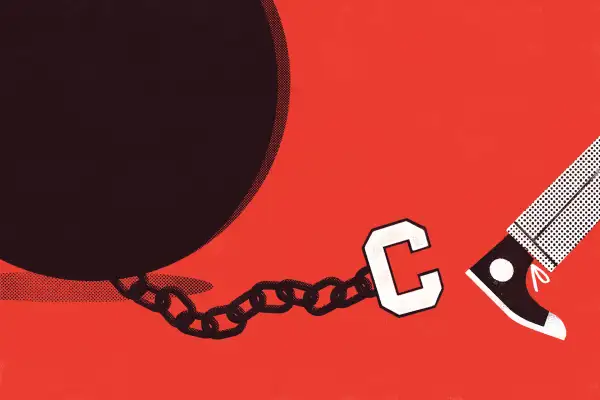Surprise! Filing for Bankruptcy Can Actually Wipe out Your Student Debt

If you’re one of the millions of Americans struggling with student debt, you may have heard about income-driven repayment plans, loan consolidation, or loan refinancing as viable options to reduce your monthly payments. But did you know you could get your student debt discharged through bankruptcy, too?
Granted, getting your student debt discharged through bankruptcy can be a long shot. But there are some experts who stress that while it's a challenge with the current law, borrowers should know it is still possible. Jason Iuliano, a law professor at Villanova University who specializes in bankruptcy and student loan debt, even has some evidence to prove it.
According to Iuliano’s data, about 40% of consumers who included student loans as part of their bankruptcy proceeding in 2007 have gotten their loans discharged — a number that has increased to 60% in the last couple of years.
The problem, he says, is that relatively few borrowers know bankruptcy is an option or are willing to try it. Why? Because throughout the years, the narrative within the media, courthouses and even amongst bankruptcy professionals has been that you can’t get student loans discharged through bankruptcy.
Is it difficult to do? Yes. Impossible? No. Consider consulting with a bankruptcy professional to explore your options, including the potential role of student loans in bankruptcy proceedings.
How to file for a student loan discharge in bankruptcy
The first thing you need to do is file for either a Chapter 7 or a Chapter 13 bankruptcy. You can do this on your own, but Iuliano recommends hiring an attorney as it is a fairly complicated process.
Chapter 7 is best suited for those who earn less than their state’s median income. It is a liquidation bankruptcy, in which most of your assets are sold to pay off your debts. This is also the most common type of bankruptcy since it’s the fastest way to a fresh start. In fact, last year alone, 440,593 Americans filed for a Chapter 7 bankruptcy, while only 233,644 filed for a Chapter 13 bankruptcy.
A Chapter 13 bankruptcy is recommended if you have a stable income and a mortgage since it is considered a “reorganization” bankruptcy. If you file for Chapter 13, you get to keep your assets. However, you must enter a repayment plan for a fixed number of years to repay creditors the equivalent of the amount they would’ve gotten if your assets had been sold.
Iuliano says that if you’ve already filed for bankruptcy but didn’t include your student loans as part of the list of debts you’d like to get cleared, you can always reopen the case to add them, without having to start the proceeding from scratch.
Regardless of the type of bankruptcy you choose, the steps to get your student loan debt wiped out are the same: you must file separate paperwork, known as an “adversary proceeding,” to get the loans discharged and prove that your student loan payments would impose an undue hardship on you — this is when things get tricky.
The law doesn’t specify what exactly is “undue hardship,” leaving this to the interpretation of the individual courthouse or judge who’s reviewing the case. However, most courts use what’s called the “Brunner test” as the standard for undue hardship.
To pass the Brunner test, you must prove three things: that paying your student loans won’t allow you to maintain a minimal standard of living, that you won’t be able to pay your loans in the foreseeable future, and that you’ve made good faith efforts to pay back your loans before you filed for bankruptcy.
If you’re able to satisfy these requirements, then you may be eligible for a full or partial loan discharge, although partial discharges are more common.
“In a lot of cases, the debt will be cut from 100 grand down to 20 grand, and the interest rate will be cut from nine or 10 percent down to one percent, for example. So, it's a very favorable settlement,” says Iuliano.
Federal student loans vs private student loans
While the process to get both federal and private student loans discharged in bankruptcy is the same, experts agree that it is far more difficult to get federal student loans discharged than private ones.
Why? For one, most federal student loan bankruptcy cases are handled by the Educational Credit Management Corporation (ECMC). Henry Sommer, president of the National Consumer Bankruptcy Rights Center, says that since ECMC’s attorneys get paid by the Department of Education, they can invest more money in litigation than attorneys from the private sector.
“ECMC will fight tooth and nail,” says Sommer. “Even in the strongest cases, they will fight, and if they lose the case, they will appeal,” he adds. In some instances, US attorneys will also be called as part of the defense team.
Hiring an attorney to handle your case could cost you between $1,200 to $3,200, depending on the type of bankruptcy you file for. If you add student loans discharge into the mix, Sommer says that this could end up costing you around $5,000 more, unless they give you a discount or agree to work the case on a pro bono basis.
But paying an experienced attorney to help your case could also hurt your chances of winning.
"They could use that against you saying, ‘Hey, you do have money because you actually were able to hire this person.’ So, it’s kind of a catch 22," says Sommer.
Another thing that could complicate things if you have federal student loans is your eligibility for an income-based repayment plan. If you're eligible for one of those plans, it might be more difficult to get a discharge, says John Rao, an attorney at the National Consumer Law Center (NCLC). The opposing attorneys could argue that you can lower your payments based on how much you earn under those programs.
Although there’s no guarantee that your loans will be discharged just because they’re private, Sommer says that private lenders “are more willing to settle” because private loans are bound by a statute of limitations. This means that, eventually, if a borrower can’t pay, lenders won’t be able to collect anything, so they try and strike a deal by offering at least a partial discharge. (The federal government, on the other hand, has a lot of power to collect from you forever — it can even take money out of your Social Security payments after you’ve retired.)
Pushing for change to improve bankruptcy options for student borrowers
Student debt used to be treated just like any other consumer debt in bankruptcy proceedings. But in 1976, Congress changed the law, with the goal of preventing abuse of loan dischargeability. Under this new law, federal borrowers had to wait at least five years after graduation and prove that repayment would impose an undue hardship, to get their loans discharged. This measure was officially incorporated into the U.S. Bankruptcy Code in 1978.
The waiting period kept changing over the years, making it harder for borrowers to get their federal loans discharged. Then, in 2005, private loans got the same strict treatment as federal loans, and “that was the final blow,” according to Rao.
Collectively, Americans now owe more than $1.5 trillion in student loan debt, which is more than what they owe on both credit card debt and auto loans. Not only that, but out of all those loans, only 60% of them are in active repayment, while 11% are in default — a number that’s expected to climb to as much as 40% by 2023.
As the student debt crisis has broadened, so has the attention on what many consumer advocates argue are too-strict bankruptcy rules.
Several current members of Congress have said they would support legislation to update the bankruptcy rules to make student loans dischargeable for struggling Americans the same way they were before 1976. President Biden campaigned on it, too.
But in Rao’s opinion, the biggest change right now is coming from the bankruptcy courts themselves. The Brunner test was developed at a time where you could discharge student loans five years after graduating.
“That is not the case now, and courts are trying to apply that standard differently,” says Rao.
In a recent case that shows how some judges’ thinking on the law has evolved, a former law student, Kevin Jared Rosenberg, who filed for a Chapter 7 bankruptcy, got over $220,000 worth of student loan debt discharged. The decision came after Cecelia Morris, chief judge for the U.S. Bankruptcy Court of the Southern District of New York, ruled in his favor, stating that Rosenberg didn’t have to prove that repaying his loans would impose an undue hardship on him forever, just for a significant period of time.
Drawbacks of filing for bankruptcy
Bankruptcy can help you get all, or part, of your student loan debt discharged, in the best of cases. But there are some disadvantages you must consider before filing for it.
It will impact your credit
First, it will have a long-lasting impact on your credit. Depending on the reporting agency and credit score range you’re at, your score could drop as much as 200 points. While this gradually improves over time, bankruptcies can stay on your credit report for up to 10 years, affecting your ability to borrow. This is something to keep in mind, especially if you’re planning to make a big purchase such as a house or a car in the near future.
Your student loan payments could increase
If you file for a Chapter 13 bankruptcy and your student loans are not discharged, there’s a possibility you could end up paying more than you were before. Under Chapter 13, you agree to make certain payments to your creditors. So, if the court rules that your payments must equal 5% of your debt, Sommer says that means that you’ll have to pay 5% on your student debt, too.
Very few attorneys work these cases
There are many attorneys that work traditional bankruptcy cases, but Iuliano points out that only a handful of them actually work on student loan bankruptcies as the main core of their practice.
“And having a good attorney is a very important part of the process,” says Iuliano.
Since getting student loans discharged is such a difficult task, you will need an attorney that knows all the tips and tricks to litigate the case effectively. If you’re unsure where to find a good attorney for your case, you can check out Lexria (formerly Reset Button), which is an online platform that connects borrowers with attorneys that specialize in student loan bankruptcies.
The bottom line
If you’re thinking about filing for bankruptcy for the sole purpose of getting your student loans discharged, you must go into the process knowing that there’s no outcome guaranteed. If you’re having trouble making payments, you should always check if you qualify for a lower payment via an income-based repayment plan. If you have private debt, try to renegotiate your current debt with the lender to get a lower monthly payment, or ask if you can defer the payments for a few months until you get back on your feet.
More from Money:
Getting Rid of Student Debt in Bankruptcy is Tough. A New Company Wants to Change That
You Can Deduct Student Loan Interest on Your 2020 Taxes Even if You Skipped Payments Last Year
Federal Student Loan Forgiveness Programs Already Exist. Why Aren't More Borrowers Taking Advantage?
